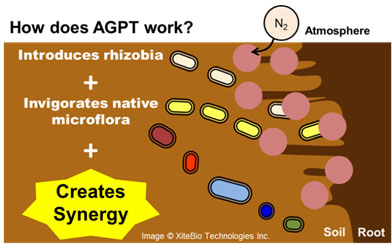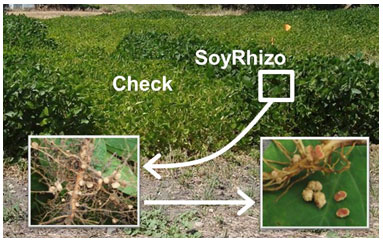Winnipeg, Manitoba, Canada
April 4, 2013
The use of inoculants for legumes is a well-established practice though high levels of variation in nodulation between different fields and different years are common. Many farmers choose not to inoculate their legumes because they see inconsistent results when they do. Whether it’s poor nodulation when using an inoculant, or adequate nodulation without using any inoculant, the results are not there to make inoculation worthwhile every time. Factors such as temperature and precipitation frequently impact the effectiveness of a seed inoculant during cropping seasons when the weather is not ideal. However, competition between the rhizobia in the inoculant and the microbes already in the soil, the native microflora, affects the success of many inoculants each year.
Each spoonful of soil contains billions of different bacteria and other microorganisms, and the process of seed inoculation adds billions more. This causes immediate competition between the microbes, as they are all fighting for the same resources. If the rhizobia in the inoculant can out-compete the native population, inoculation will be successful, nodules will form, and they will begin nitrogen fixation.
If, however, the native microflora is successful, the introduced rhizobia will struggle for survival. These unfavourable conditions for the introduced rhizobia prevent the colonisation of roots and nodule formation and result in less nitrogen fixation for the crop. It is possible for some nodules to still form even if the rhizobia in the inoculant are unsuccessful in forming nodules. This is most common in regions with a long history of inoculation where some rhizobia remain in the soil from previous seasons and are able to colonise the roots of subsequent crops. This interaction between introduced and native microflora depends on many factors, including soil type and texture, weather, and cropping history. The complexity of this interaction makes it nearly impossible to accurately predict the success of inoculants that compete against existing soil microflora.
Not all interactions between soil bacteria are competitive and some legume inoculants are actually able to stimulate the native microflora and create synergy between the native and introduced rhizobia. “Harnessing the plant growth promoting abilities of the native soil bacteria is revolutionary in inoculant technology” says Dr. Manas Banerjee, President & CEO of XiteBio Technologies Inc., where Advanced Growth Promoting Technology (AGPT™) was developed. “AGPT™ inoculants invigorate the native microflora and create a partnership, a synergistic interaction, between the introduced and native rhizobia”, Dr. Banerjee continues, “creating additional opportunities for nodule formation on all roots, boosting higher nitrogen fixation, and increasing yields at harvest”.

Advanced Growth Promoting Technology (AGPT), available in SoyRhizo soybean inoculant and PeasRhizo pea & lentil inoculant, introduces optimum levels of specific rhizobia to form nodules and fix nitrogen and then invigorates the native microflora, including native rhizobia, and creates synergy between the introduced and native rhizobia. This results in stronger roots, healthier plants, and higher yields.
Every soil contains various rhizobia and many other beneficial bacteria, each of which have their own beneficial properties that enable them to help crop development. “Before AGPT™, the positive effects of these native bacteria would be supressed, resulting in highly variable nodulation and yields”, Dr. Banerjee explains, “and with AGPT™ inoculants, those benefits are promoted, interactions between the native and introduced rhizobia are stimulated, and helps in the development of more root nodules, healthier crops, and greater yields.”

Soybean trial with SoyRhizo inoculant showing enhanced nodulation and active nitrogen fixation in root nodules (pink nodule interior).
“Growers are saying that they see more robust nodulation and more uniform yields when using AGPT™ based inoculants like XiteBio SoyRhizo for soybean or XiteBio PeasRhizo for pea & lentil”, says Garry Van Den Bussche, Director of Sales & Marketing at XiteBio. AGPT™ based inoculants are low-volume, fast-drying liquid products featuring an all-in-one package with no mixing required. Two formulations of AGPT™ based inoculants have been commercialised: XiteBio SoyRhizo inoculant for soybean and XiteBio PeasRhizo inoculant for pea & lentil. SoyRhizo and PeasRhizo are available in the USA; Canadian registrations are expected soon.
For further information, please contact Garry Van Den Bussche, at 204-297-4639 or toll-free 1-855-XITEBIO (948-3246), garry.vandenbussche@xitebio.ca or visit www.xitebio.ca.